NCERT Class 11 Maths Chapter 1 Notes Sets - Download PDF
Want to grasp relationships, functions, and probability? It all begins with Sets. Sets allow you to recognise patterns, sequences, and membership in the numerical world. Picture yourself as the one who has to collect the participants' list for your college's yearly fest, which has different events. Now, some participants' names are in more than one category, and to avoid any duplication, you need to compare and group these lists. NCERT Class 11 Maths Chapter 1 notes on Set theory come into play in these types of situations and prove to be the saviour by comparing and organising the data. In these notes on Sets for class 11, we will cover some definitions and procedures involving sets. These NCERT notes for class 11 Maths help to make learning uncomplicated, simple, and easy in a stress-free environment.
This Story also Contains
- Class 11 Sets Notes PDF – Download Free Study Material
- Sets Class 11 Notes
- How to Use the Sets Class 11 Notes Effectively?
- Sets Class 11 Notes: Previous Year Question and Answer
- NCERT Class 11 Maths Notes Chapter-Wise Links
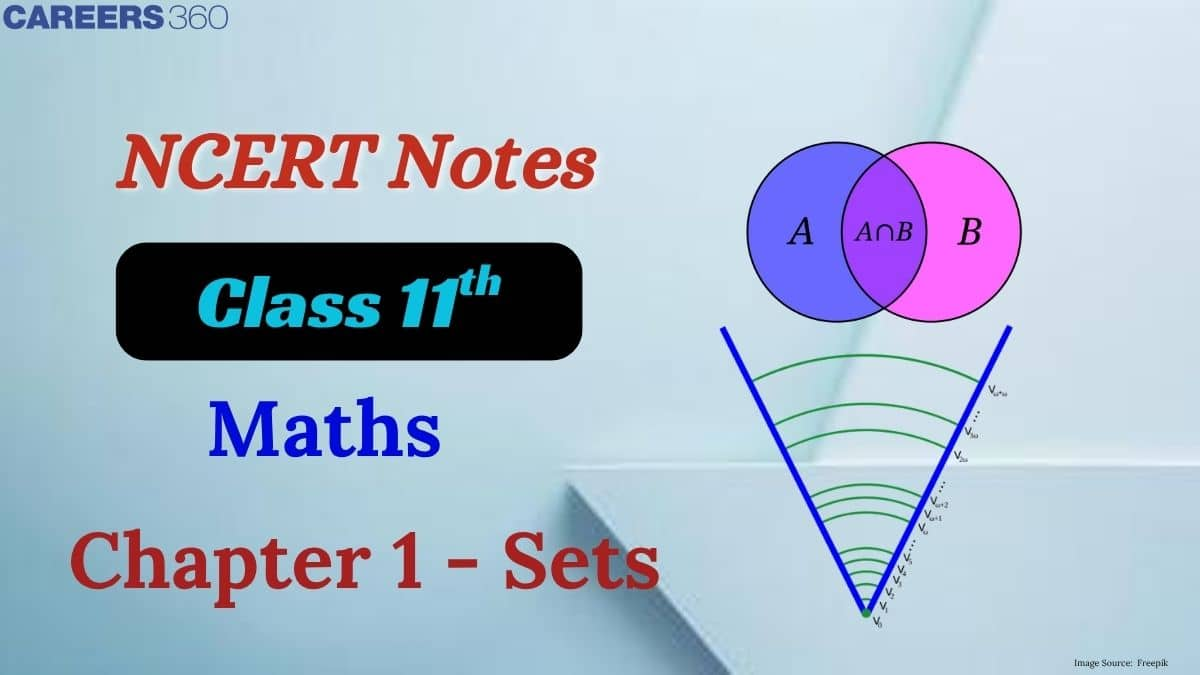
Sets are the foundation of modern mathematics and have many uses in real life. Understanding these core concepts well will help you score better in your Class 11 exams and in many competitive exams too. Students can rely on these Sets Class 11 notes to revise and strengthen concepts after practising the textbook exercises. Curated by Careers360 experts, these NCERT notes strictly follow the updated NCERT syllabus, ensuring focused and effective learning. Explore NCERT Books, Solutions, Syllabus, and Exemplar Problems with Solutions for complete syllabus coverage in this NCERT article.
Also, read,
Class 11 Sets Notes PDF – Download Free Study Material
Students who wish to access the NCERT Class 11 Maths Chapter 1 Notes can click on the link below to download the entire solution in PDF.
Sets Class 11 Notes
Careers360 has prepared these NCERT Class 11 Maths Chapter 1 Notes to make your revision smoother and faster.
Sets
A set is a well-defined collection of elements. These elements may include numbers, symbols, variables, etc.
We generally represent them using capital letter(A, B, C, D, Z, N etc)
Elements in the sets are represented by small letters(a, b, c, d, e)
Elements of sets are represented using closed brackets { } .
Examples of sets:
- i) set of first n natural numbers: N = 1, 2, 3, 4, 5,.....,n
- ii) set of rational numbers: R.
- iii) set of whole numbers: W.
- iv) set of positive integers: Z+
- v) set of negative integers: Z-
Representation of Sets
We have 2 methods to represent a set:
1. Roster or Tabular Form
In roster form, all the elements of a set are listed; the elements are separated by commas and are enclosed within braces $\{ \}$.
Example: $\{\mathrm{a}, \mathrm{e}, \mathrm{i}, \mathrm{o}, \mathrm{u}\}$ represents the set of all the vowels in the English alphabet in roster form.
In roster form, the order in which the elements are listed is immaterial, i.e. the set of all natural numbers which divide 14 is $\{1,2,7,14\}$ and can also be represented as $\{1,14,7,2\}$.
An element is not generally repeated in the roster form of a set, i.e., all the elements are taken as distinct. For example, the set of letters forming the word 'SCHOOL' is $\{\mathrm{S}, \mathrm{C}, \mathrm{H}, \mathrm{O}, \mathrm{L}\}$ or $\{\mathrm{H}, \mathrm{O}, \mathrm{L}, \mathrm{C}, \mathrm{S} \}$. Here, the order of listing elements has no relevance.
2. Set-Builder Form
In set-builder form, all the elements of a set possess a single common property that is not possessed by any element outside the set. If $Z$ contains all values of $x$ for which the condition $q(x)$ is true, then we write
$
Z=\{x: q(x)\} \text { or } Z=\{x \mid q(x)\}
$
Where ': ' or ' | ' is read as 'such that'
eg. The set $A=\{0,1,8,27,64, \ldots$.$\}$ can be written in Set Builder form as
$\mathrm{A}=\left\{\mathrm{X}^3: \mathrm{X}\right.$ is a non-negative integer $\}$
Types of Sets
Empty set: A set that does not contain any elements and is empty. Such sets are called empty or null, or void sets.
Represented as: { } or ∅
$E g: A=\{x: 1<x, x$ is a natural number $\}$
So A is an empty set, as we don't have any natural element that is less than 1.
Finite set: A set that is empty or consists of a finite number of elements is called a finite set.
Examples: $\varphi,\{\mathrm{a}\},\{1,2,5,9\},\{\mathrm{x}: \mathrm{x}$ is a person of age more than 18$\}$
Infinite set: A set that has infinite elements is called an infinite set.
Examples:
a set of all the lines passing through a point,
set of all circles in a plane,
set of all points in a plane,
$N, Z, Q, Q ', R$
$\{x: 2<x<2.1\}$
Note: All finite sets can be represented in set-builder form, but infinite sets cannot be represented in set-builder form because they have no fixed pattern.
Singleton set: A set which is having only one element is called a singleton set.
Example: $\{3\},\{b\}$,
$\{\{1,2,3\}\}$ is also a singleton as it has one element, which is a set.
$\{\varphi\}$ is also a singleton set
Note: Empty and singleton sets are finite sets.
Equal sets: Sets where two sets have exactly the same elements.
Represented by the symbol: “ = “
Examples:
i) Let A, B be two sets.
A = set of natural even elements less than 10
A = {2, 4, 6, 8}
B = set of multiples of 2 less than 10 that are natural
B = {2, 4, 6, 8}
Here, A = B. Since every element of A is also an element of B, and vice versa.
ii) A = {1, 2, 3, 4}
B = {1, 3, 2, 1, 4, 1}
Then also A = B, the set elements do not change even if repeated.
The order of the elements also doesn’t matter.
Subset
Any Set that has every element of another set is called a subset.
Representation: A⊂B if a ∈A ⇒ a ∈B
The above representation means that A should have every element of set B, but B need not have every element of A.
Note: Every set is a subset of itself
E.g.: A = {1, 3, 5, 7, 9}
B = {1, 2, 3, 4, 5, 6, 7, 8, 9}
A ⊂ B because every element of A is in B, but not every element of B is in A.
Venn diagram of a subset
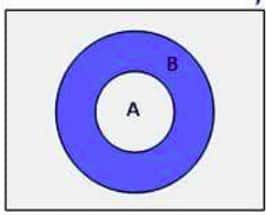
Proper set: If A⊂B and A≠B, then such a set A is called a proper subset of B.
B is called the superset of A.
E.g.: A = {1, 2, 3, 4, 5, 6}
B = {1, 2, 3, 4, 5, 6, 7, 8}
Here A⊂B and A≠B.
So, A is a proper subset of B.
B is a superset of A.
Intervals of subsets
When a,b ∈ real numbers, a<b then,
Set of real numbers: {x: a<x<b} is an open interval, represented as (a, b).
The set that includes endpoints also then such intervals are closed intervals.
{y: a ≤ y ≤ b}, closed interval represented by [a, b].
Eg: (p, q] ⇒ {x: p < x ≤ q}
Here in the set elements include q and exclude p.
Pictorial representation of intervals
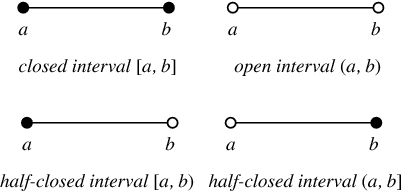
Power set: It is a set that is a collection of all subsets, including the null or empty set, and itself denotes a power set.
Represented by p(A).
E.g.: A = {1, 2, 3, 4}
Subsets: ∅, {1}, {2}, {3}, {4}, {1, 2}, {1, 3}, {1,4}, {2,3}, {2, 4}, {3, 4}, {1, 2, 3}, {1, 2, 4}, {1, 3, 4}, {2, 3, 4}, {1, 2, 3, 4}
Total subsets:16
Points:
-
First is a null set
-
Next singleton sets(sets with one element}
-
Next, with two elements
-
The set itself
Remember: {1, 2} = {2, 1}
(The order doesn’t matter, so it should be written only once.)
A formula to find a number of subsets
$\mathrm{m}=$ number of elements in set A
Formula: $2^m$
$E g: A=\{1,2,3,4\} \quad t=2^4=16$. We found the same above.
$
A=\{1,2,3,4\}
$
Subsets: ∅, {1}, {2}, {3}, {4}, {1, 2}, {1, 3}, {1, 4}, {2, 3}, {2, 4}, {3, 4}, {1, 2, 3}, {1, 2, 4}, {1, 3, 4}, {2, 3, 4}, {1, 2, 3, 4}
Total subsets:16
Universal Set
The set that includes all the elements is called a universal set.
Represented using U.
Venn Diagram:
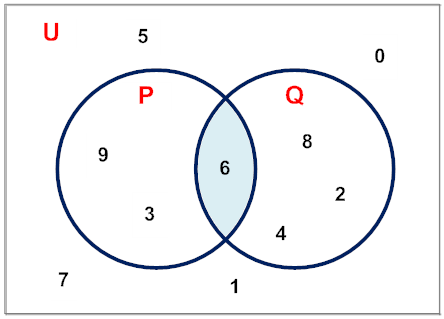
{0, 1, 2, 3, 4, 5, 6, 7, 8, 9} all belong to the universal set.
Operation of Sets
Union of sets: The set contains all the elements of A and B, and repeating elements of both sets A, B are taken only once.
Represented by: ∪
Read as A union B.
Set builder form of union sets:
{y: y∈A or y∈B}
Venn diagram of union:
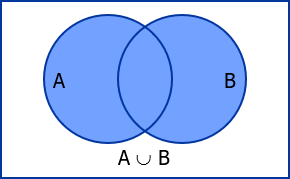
Eg: A = {1, 2, 3, 4, 5} B = {2, 4, 5, 6, 7, 8}
A∪B = {1, 2, 3, 4, 5, 6, 7, 8}
Properties of union
- $A \cup B=B \cup A \quad$ (Commutative Property)
- $(A \cup B) \cup C=A \cup(B \cup C)$ (Associative property)
- $\mathrm{A} \cup \varphi=\mathrm{A}$ (Law of identity element, $\varphi$ is the identity of Null Set)
- $\mathrm{A} \cup \mathrm{A}=\mathrm{A}$ (Idempotent law)
- $U \cup A=U($ Law of $U)$
- If $A$ is a subset of $B$, then $A \cup B=B$
The Intersection of Sets
This set contains the elements that are common to the sets.
Represented as: ∩
Read as A intersection B.
Set builder form of intersection:
{y: y ∈ A and y ∈ B}
Venn diagram of AB:
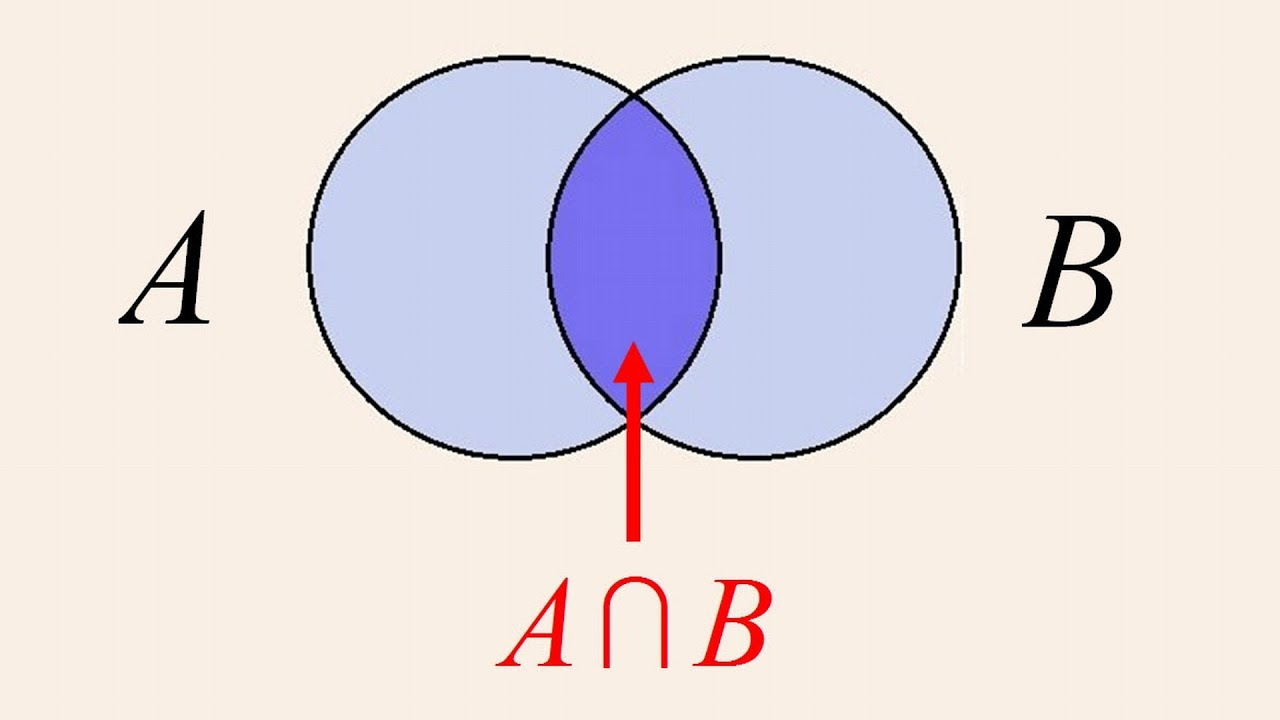
Eg: A = {1, 2, 3, 4, 5, 6} B = (2, 4, 6, 8, 10}
A∩B = {2, 4, 6}
Properties of the intersection
- $\mathrm{A} \cap \mathrm{B}=\mathrm{B} \cap \mathrm{A}$ (Commutative law).
- $(A \cap B) \cap C=A \cap(B \cap C)$ (Associative law).
- $\mathrm{A} \cap \phi=\phi$,
- $\mathrm{A} \cap \mathrm{U}=\mathrm{A}$ (Law of $\phi$ and U$)$.
- $\mathrm{A} \cap \mathrm{A}=\mathrm{A}$ (Idempotent law)
- If $A$ is subset of $B$, then $A \cap B=A$
Difference of Sets
In the set, the elements belong to A but do not belong to B; such sets are called Differences of sets.
Represented as: A-B
Set builder form: {y: y ∈ A and y ∉ B}
Venn diagram of A - B:
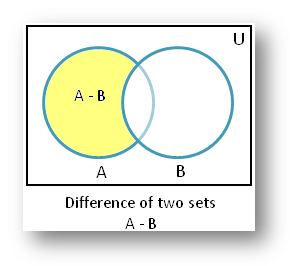
E.g.: A = {1, 2, 3, 4, 5}
B = {2, 3, 4, 8, 9}
A - B = {1, 5}
Here, even though we have {2, 3, 4} in A, as they also belong to B, we also do not include them in A - B.
Complement of a set
The elements other than A that are in the universe come under complementary elements.
Represented by: A’
Set builder form: {y: y ∈ U and y ∉ A}
Venn diagram:
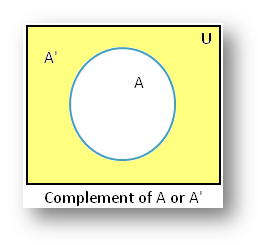
Eg: A = {y: y ∈ U and not divisor of 24}
A’ = {1, 2, 3, 4, 6, 8, 12, 24}
Properties of complement sets
-
A∪A’ = U (complement laws)
-
A∩ A’ = ∅ (complement laws)
-
(A∪B)’ = A’∩B’ (Demorgan’s law)
-
(A∩B)’ = A’∪ B’ (Demorgan’s law)
-
(A’)’ = A (double complement)
-
U’ = ∅ and ∅’= U
De-Morgan’s Laws
1. (A ∪ B)′ = A′ ∩ B′
Let $x$ be any element in $(A \cup B)^{\prime}$.
$
\begin{aligned}
& x \in(A \cup B)^{\prime} \Longleftrightarrow x \notin(A \cup B) \\
& x \notin(A \cup B) \Longleftrightarrow x \notin A \text { and } x \notin B
\end{aligned}
$
(Reason: If $x$ is not in the union, it cannot be in $A$ and it cannot be in $B$.)
$
\begin{aligned}
& x \notin A \Longleftrightarrow x \in A^{\prime} \\
& x \notin B \Longleftrightarrow x \in B^{\prime}
\end{aligned}
$
Therefore,
$
x \notin A \text { and } x \notin B \Longleftrightarrow x \in A^{\prime} \text { and } x \in B^{\prime}
$
So,
$
x \in A^{\prime} \text { and } x \in B^{\prime} \Longleftrightarrow x \in\left(A^{\prime} \cap B^{\prime}\right)
$
Hence,
$
x \in(A \cup B)^{\prime} \Leftrightarrow x \in\left(A^{\prime} \cap B^{\prime}\right)
$
Thus, both sets contain exactly the same elements.
Therefore,
$
(A \cup B)^{\prime}=A^{\prime} \cap B^{\prime}
$
2. (A ∩ B)′ = A′ ∪ B′
Let $x$ be any element in $(A \cap B)^{\prime}$
$
x \in(A \cap B)^{\prime} \Leftrightarrow x \notin(A \cap B)
$
$k x \notin A$ or $x \notin B \quad$ (as $x \notin(A \cap B)$, means it is not common in $A$ and $B$, and thus either it is not in $A$ or not in B)
$
\begin{aligned}
& \Leftrightarrow x \in A^{\prime} \text { or } x \in B^{\prime} \\
& \Leftrightarrow x \in\left(A^{\prime} \cup B^{\prime}\right) \\
& \therefore x \in(A \cap B)^{\prime} \Leftrightarrow x \in\left(A^{\prime} \cup B^{\prime}\right)
\end{aligned}
$
So, any element that belongs to $(A \cap B)^{\prime}$ also belongs to $\left(A^{\prime} \cup B^{\prime}\right)$, and vice versa
So, these sets have exactly the same elements.
Hence, they are equal.
Theorems and Proofs
Theorem 1:
n(A∪B) = n(A) + n (B) - n(A∩B)
Proof:
n ( A – B) + n ( A ∩ B ) + n ( B – A )
⇒ n(A) - n ( A ∩ B ) + n(B) - n( A ∩ B ) + n( A ∩ B )
⇒ n(A) + n(B) - n( A ∩ B )
Hence, it is proved.
Theorem 2: n(A ∪ B ∪ C ) = n ( A ) + n ( B ) + n ( C ) – n ( A ∩ B ) – n ( B ∩ C) – n ( A ∩ C ) + n ( A ∩ B ∩ C )
Proof:
n ( A ∪ B ∪ C ) = n (A) + n ( B ∪ C ) – n [ A ∩ ( B ∪ C ) ]
⇒ n (A) + n ( B ) + n ( C ) – n ( B ∩ C ) – n [ A ∩ ( B ∪ C ) ]
⇒ n [ A ∩ ( B ∪ C ) ] = n ( A ∩ B ) + n ( A ∩ C ) – n [ ( A ∩ B ) ∩ (A ∩ C)] n ( A ∩ B ) + n ( A ∩ C ) – n (A ∩ B ∩ C)
Similarly for the other two:
Finally, it is proved.
n ( A ∪ B ∪ C ) = n (A) + n ( B ) + n ( C ) – n ( A ∩ B ) – n ( B ∩ C) – n ( A ∩ C ) + n ( A ∩ B ∩ C )
How to Use the Sets Class 11 Notes Effectively?
Sets is the first chapter of Class 11 Maths, and it serves as the base for many topics we will study later. It helps us understand how to group, compare, and organise information clearly. To study well, we need to use our Class 11 Maths Chapter 1 notes smartly and simply. Here are some more points on how these notes are important.
- Go through each topic step by step from Introduction to Complement of a Set, so you don’t miss the basics like empty set, subsets, and Venn diagrams.
- Practice operations on sets and draw Venn diagrams while reading, as these visuals make the concepts easier to remember.
- Try connecting the ideas from your NCERT Class 11 Maths Chapter 1 notes of higher classes, because sets are used in probability, relations & functions, and even computer science later.
- Revise the NCERT Class 11 Maths Chapter 1 notes regularly and solve simple questions after each topic to check if you truly understand it.
Sets Class 11 Notes: Previous Year Question and Answer
Given below are selected previous year question answers for NCERT Class 11 Maths Chapter 1 Sets, collected from various examinations.
Question 1:
If A and B are two sets, then A ∩ (A ∪ B) equals:
Solution:
Let $x \in A \cap(A \cup B)$
$
\begin{aligned}
& \Rightarrow x \in A \text { and } x \in(A \cup B) \\
& \Rightarrow x \in A \text { and }(x \in A \text { or } x \in B) \\
& \Rightarrow(x \in A \text { and } x \in A) \text { or }(x \in A \text { and } x \in B \\
& \Rightarrow x \in A \text { or } x \in A \cap B
\end{aligned}
$
Hence, the correct answer is "A".
Question 2:
Two finite sets have m and n elements. The number of subsets of the first set is 112 more than that of the second set. The values of m and n are, respectively:
Solution:
According to the question we have,
$
\begin{aligned}
& 2^m-2^n=112 \\
& 2^n\left(2^{m-n}-1\right)=2^4 \times 7 \\
& 2^n=2^4 \text { and } 2^{m-n}-1=7 \\
& n=4 \text { and } 2^{m-n}=1+7=8=2^3 \\
& n+4 \text { and } m-n=3 \\
& m=7
\end{aligned}
$
Hence, the correct answer is 7 and 4.
Question 3:
If sets A and B are defined as $A = \left\{(x,y):y= \frac{1}{x}, 0\neq x\in R \right \}\prod $ $B= \left\{(x,y):y= -x, x\in R \right \}$, then
Solution:
Given that $A = \left\{(x,y):y= \frac{1}{x}, 0\neq x\in R \right \}$ and $B= \left\{(x,y):y= -x, x\in R \right \}$
So, $y = \frac{1}{x}$ and $y = - x$
$\frac{1}{x} \neq - x$
$A\cap B = \phi$
Hence, the correct answer is "A ∩ B = φ".
NCERT Class 11 Maths Notes Chapter-Wise Links
We at Careers360 compiled all the NCERT class 11 Maths notes in one place for easy student reference. The following links will allow you to access them.
|
NCERT Class 11 Maths Chapter 1 Notes |
NCERT Exemplar Solutions Subject-Wise
The following links contain subject-wise NCERT exemplar solutions. These solutions help you become familiar with the concepts and score well in the exam.
- NCERT Exemplar Class 11 Solutions
- NCERT Exemplar Class 11 Maths
- NCERT Exemplar Class 11 Physics
- NCERT Exemplar Class 11 Chemistry
- NCERT Exemplar Class 11 Biology
NCERT Solutions Subject-Wise
The following list contains subject-wise NCERT solutions. These solutions cover all the concepts comprehensively.
- NCERT Solutions for Class 11 Mathematics
- NCERT Solutions for Class 11 Chemistry
- NCERT Solutions for Class 11 Physics
- NCERT Solutions for Class 11 Biology
NCERT Books and Syllabus
Students can use the following links to check the latest NCERT syllabus and read some reference books.
Frequently Asked Questions (FAQs)
A set is a well-defined collection of distinct objects or elements. The objects in a set are called elements or members.
For example, the set of natural numbers less than 10 can be written as
A = {1,2,3,4,5,6,7,8,9}.
The Sets chapter usually carries around 4 to 6 marks in the Class 11 Maths exam. It is a fundamental chapter and serves as the foundation for many other topics, so it is an important area to focus on during preparation.
Yes, the Sets chapter is important for competitive exams like JEE Main and JEE Advanced. Although the JEE Main may weigh this chapter less than others, it still contributes to the General Aptitude and Mathematics sections.
In JEE Main, expect 1-2 questions on Sets worth 4-6 marks in total.
The questions from the Sets chapter typically fall into the following categories:
Definition-based questions
Set operations
Venn diagram-based problems
Set-builder form questions
Power set and Cartesian product
Application-based word problems
Complement of a set
Here are a few daily life examples where sets are used, based on NCERT Class 11 Maths Chapter 1:
Students in a class with Different Hobbies
Shopping Lists and Preferences
Grocery Store
Classroom Attendance Tracking
Selection of Teams or Groups
Student Performance Analysis in Subjects
Library Book Categories
Social Media Friendships and Connections
Survey on Favourite Foods or Activities
Courses After 12th
Applications for Admissions are open.
As per latest syllabus. Physics formulas, equations, & laws of class 11 & 12th chapters
JEE Main Important Chemistry formulas
Get nowAs per latest syllabus. Chemistry formulas, equations, & laws of class 11 & 12th chapters
JEE Main high scoring chapters and topics
Get nowAs per latest 2024 syllabus. Study 40% syllabus and score upto 100% marks in JEE
JEE Main Important Mathematics Formulas
Get nowAs per latest syllabus. Maths formulas, equations, & theorems of class 11 & 12th chapters
